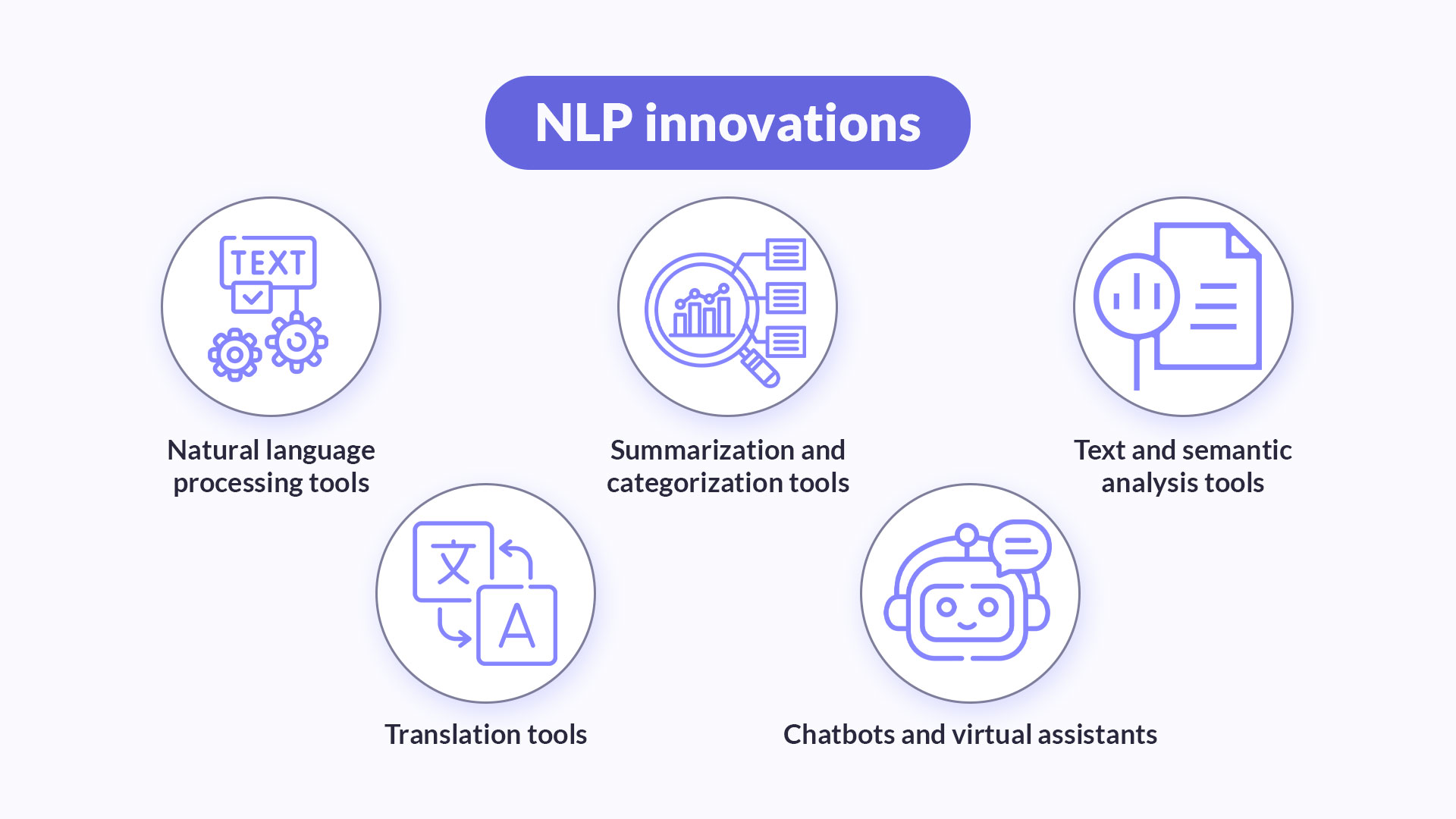- How NLP applications in education innovate corporate learning
- Use case: interactive learning modules powered by NLP chatbots
- Use case: language skills development for international business
- Use case: simulated business scenarios for employee training
- Use case: knowledge extraction from documents
- Future perspectives for NLP in corporate education
- Conclusion
Natural language processing (NLP) has removed the language barrier between machines and humans. Here’s the point: it allows computers to recognize, understand, and produce text and speech. This innovation lies at the core of many artificial intelligence applications, including chatbots, digital voice assistants, dictation software, and text translation tools. These are just some of the applications of NLP in education, and companies are taking notice.
In fast-paced working environments, employees have an average of 1% of their work hours to dedicate to learning. If that’s not bad enough, most workers have different roles and experience levels. So, a one-size-fits-all approach to training doesn’t work.
Dive in to learn how NLP techniques are reshaping the corporate education industry through personalized learning experiences.In this article:
How NLP applications in education innovate corporate learning

Sitting at the intersection of computer science and linguistics, natural language processing uses rule-based modeling of human language. But the main point is that it is democratizing access to AI and innovation. Gone are the days when you had to master machine learning, deep learning algorithms, and NLP technologies to reap their benefits. Now, anyone can tap into the power of AI and unlock meaningful insights. All it takes is a simple prompt in human language.
So, with ease of use, we have many applications of natural language processing in the education sector:
Natural language processing tools for writing and reading assistance. These tools use NLP capabilities such as speech-to-text and text-to-speech conversion, autocorrect, and autocomplete.
NLP education tools for writing and reading assistance. These tools use NLP capabilities such as speech-to-text and text-to-speech conversion, autocorrect, and autocomplete.
Document summarization and content categorization tools for quick processing. NLP technology allows machines to assign tags or categories to text based on content (language, topic, sentiment). It can also quickly pull the most relevant information from the text and summarize it.
Text analysis tools for determining the meaning of words in context. Computers employ word sense disambiguation and contextual understanding based on what the educational content is about.
Translation tools for understanding and learning foreign languages. Natural language processing is key to effective machine translation. Sentences, paragraphs, and entire texts require contextual understanding and sentiment analysis for effective translation.
Chatbots and virtual assistants for answering user questions. Chatbots harness natural language understanding and sentiment analysis to understand the question and detect urgency. Then, they create answers using natural language generation. The answers are instant and concise, and conversational artificial intelligence makes the interaction flow naturally.
Natural language processing tools have opened a world of new possibilities in the educational sector. Let’s explore how these NLP tools are affecting the corporate learning environment.
Explore our AI-powered app development services
Embrace artificial intelligence to automate internal processes, enhance customer engagement, and uncover valuable insights.
Use case: Interactive learning modules powered by NLP chatbots
Imagine an employee reading through boring chunks of text. Now imagine the same person using an app to pick realistic scenarios and discuss questions with a virtual assistant. Who do you think will learn more?
That’s why companies use NLP systems to create interactive learning modules. These modules often use NLP-driven chatbots and virtual assistants. Employees can ask questions, provide answers, and get instant feedback. The content they will see next is a direct consequence of their interactions, estimated skill levels, and business roles.
Let’s see what benefits interactive learning modules have in the business context:
Learning sequences depend largely on student interactions.
Learning is available at any time and for any duration via smart devices.
Learning is more informal and personal. Each employee can progress at their own pace.
Employees are motivated to learn through interaction with the chatbot, eliminating the fear of judgment from instructors and peers.
Learners get automated feedback and opportunities for improvement. Employers have direct insight into skill levels.
NLP chatbot in action: Accenture’s Digital People Advisor answers two million questions in the first year.
To leverage the benefits of natural language processing in education, the Accenture team developed their chatbot. Their HR employees were often overwhelmed by the various sources they had to use to get information. So, they developed a Digital People Advisor, or DiPA, to address employee queries. Since its launch, employees have gotten personalized responses, filtering options, and more advanced context-based replies. During the first year alone, 110,000 employees learned from DiPA through answers to two million questions.

You may be interested
Why an AI-driven knowledge management system can be a game-changer for enterprise?
Learn how combining AI with knowledge management helps businesses find solutions faster and more accurately.
Read the whole thingUse case: Language skills development for international business
In today’s global business environment, language learning is essential. So, many companies try to help their staff improve their communication skills in different environments. Here, NLP in education has had a profoundly positive impact on language learning. Machine translation, speech recognition, semantic analysis, and automated feedback are just some of its useful features.
But how does it all work? Essential grammar lessons and assessments integrate seamlessly into the learning environment. The digital learning environment can also provide students with pronunciation and cultural nuances.
The result: your employees won’t be embarrassed (and won’t embarrass you!) when they need to speak with international partners or customers.
Let’s review the benefits of using NLP solutions in corporate language learning:
Learning sequences depend on employee roles, proficiency levels, and interactions with educational materials.
Pronunciation feedback and assistance are instant. Speaking practices are frequent and individualized.
Grammar is implied, with rules available for reference. Corrections are instant.
Vocabulary is relevant for context and roles, including highly specialized words and phrases.
Content, lessons, and practices are personalized and available on demand. Learning is gamified, further increasing motivation.
Insight collaborates with Babbel to improve English competency for 60% of workers.
With over 6,500 employees worldwide, Insight operates in English- and German-speaking markets. Their German employees wanted to improve their skills and confidence when using English at work. The Babbel platform offered a placement test. Each learner had a starting point based on their proficiency level. The algorithms then offered them lessons for individual practice. More than a third of employees said they reduced their language barriers. A notable 60% saw clear improvements in their second language competency.


Thank you for Subscription!
Use case: Simulated business scenarios for employee training
Your employees are faced with a crisis. There was an accident in your production facility that landed three workers in the hospital and broke a vital part in the production line. Your customers expect their shipment to arrive on time. What does your staff do first?
First of all, relax. It’s just a practice run, and you can use it to train your employees on exactly what to do. AI algorithms, combined with natural language processing, can help you create this type of real-world business scenario for training. The practical experience will help your workers while there are no adverse consequences in the real world. So, simulations like this that use student responses and give automated feedback are invaluable.
The benefits of NLP-based simulations in professional educational settings include:
Employees are motivated to learn through real-world examples. Scenarios are engaging and relevant to specific roles.
Learners can use a trial-and-error approach to see what would happen if they made different choices.
Employees will strengthen their decision-making and problem-solving skills. They will gain confidence in dealing with uncertainty.
There is less fear of making mistakes, as there are no business consequences or judgment.
Avi Medical partners with Zavvy for scenario-based employee training in just ten minutes per week.
Avi Medical operates in a highly regulated medical market in Germany. In addition to taking care of patients, their doctors had to master internal processes and documentation. So, the company partnered with Zavvy. The goal was to create scenario-based microlearning programs for all their staff. With just ten minutes of learning per week, this method produced excellent reviews, high participation, and fewer errors.

More on the topic
5 ways to benefit from machine learning in Edtech
What machine learning is and how it helps educators make better decisions using data? Read this article to find out.
ExploreUse case: knowledge extraction from documents
How would you like to have on-demand virtual assistants to help you create training materials? These assistants will pull all the important and up-to-date information from various sources. Then, they will tag and organize entities and topics. You won’t have to sift through volumes of documents, manuals, and reports. You won’t have to worry about citations and plagiarism.
With natural language processing, educators can simplify the content creation for learning materials. Using artificial intelligence algorithms, you can pull entire sentences from documents as extractive summarization. You can also opt for abstractive summarization and get new sentences from tagged data.
Do you see the far-reaching consequences in educational settings? Educational institutions and companies alike can streamline the creation of training materials with NLP.
Here are the benefits of using NLP algorithms to extract knowledge from documents:
Quick research progress saves time.
All relevant and up-to-date information is pulled out and summarized. It reduces human effort, expenses, and error rates.
Organizing content into lessons is faster based on topic and entity tagging.
Educators can detect and quickly remove duplicate content.
It’s easy to create assessments and scenarios from the data.
PayU works with Docsumo to process 100,000 loan applications a month with 99% accuracy.
PayU processes more than 100,000 loan applications a month. Workers were manually scanning documents and bank statements and extrapolating data from them. Then they started using Docsumo’s smart APIs. What used to be double manual entry now goes straight through processing 95% of the time, improving customer experiences. They process unstructured data ten times faster, and data accuracy is at 99%.
The results of using NLP algorithms in business are compelling. Does your company need help with overwhelming manual tasks and employee training? Using AI and machine learning may be the key to unlocking your full potential. The Geniusee experts can set you up with data collection and annotation, sentiment analysis, signal processing, and other custom AI solutions for your business needs.
Future perspectives for NLP for education

The education sector has already advanced thanks to NLP and computer science. When it comes to the corporate education domain, we can expect an increase in adoption and sophistication.
Here is what we can expect from NLP in education in the future:
Improved contextual understanding. We will have more natural interactions with chatbots. Language learning will advance.
Improving NLP tasks through other media input (multimodal NLP). Learning experiences will be more nuanced and immersive when machines can also consider audio and visual input for context and sentiment.
Few-shot and zero-shot learning. We will have a wider scope of educational applications and languages available. Language models will advance.
Cross-lingual and multilingual NLP. Deep learning models will improve language learning and understanding.
Improved personalization. Learning experiences, suggestions, and recommendations will get better.
As Ben Eubanks, the author of Artificial Intelligence for HR, said, “What I ultimately envision is a self-developing workforce that is guided by AI and other technologies to fill in critical skills gaps and develop key capabilities based on the needs of the business, enabling greater organizational performance.”
Conclusion
As computer science and machine learning evolved, machines got better at understanding and structuring human language. The benefits of natural language processing in education multiplied. In the corporate learning setting, it eases knowledge extraction and improves employees’ language skills, decision-making, and problem-solving abilities. What’s best is that the learning experience is often based on scenarios and bite-sized knowledge chunks. This means employees will gladly take part in their personalized training journeys.





















